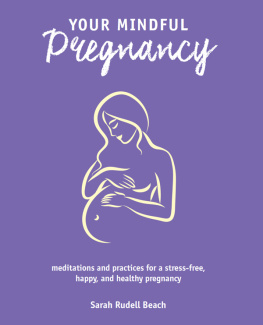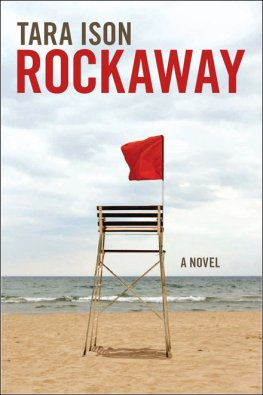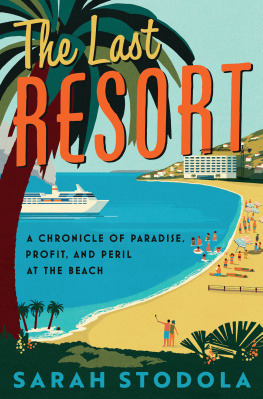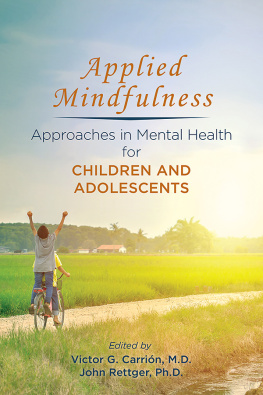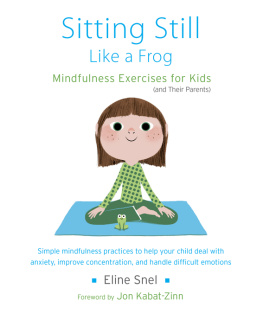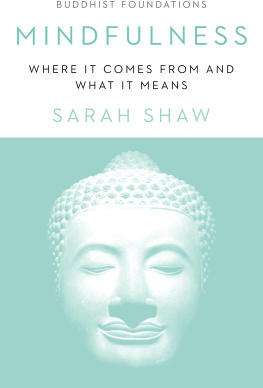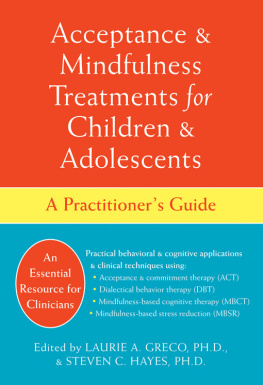Sarah Rudell Beach - Mindfulness for Children
Here you can read online Sarah Rudell Beach - Mindfulness for Children full text of the book (entire story) in english for free. Download pdf and epub, get meaning, cover and reviews about this ebook. year: 2020, publisher: Ryland Peters & Small, genre: Children. Description of the work, (preface) as well as reviews are available. Best literature library LitArk.com created for fans of good reading and offers a wide selection of genres:
Romance novel
Science fiction
Adventure
Detective
Science
History
Home and family
Prose
Art
Politics
Computer
Non-fiction
Religion
Business
Children
Humor
Choose a favorite category and find really read worthwhile books. Enjoy immersion in the world of imagination, feel the emotions of the characters or learn something new for yourself, make an fascinating discovery.
- Book:Mindfulness for Children
- Author:
- Publisher:Ryland Peters & Small
- Genre:
- Year:2020
- Rating:5 / 5
- Favourites:Add to favourites
- Your mark:
- 100
- 1
- 2
- 3
- 4
- 5
Mindfulness for Children: summary, description and annotation
We offer to read an annotation, description, summary or preface (depends on what the author of the book "Mindfulness for Children" wrote himself). If you haven't found the necessary information about the book — write in the comments, we will try to find it.
Mindfulness for Children — read online for free the complete book (whole text) full work
Below is the text of the book, divided by pages. System saving the place of the last page read, allows you to conveniently read the book "Mindfulness for Children" online for free, without having to search again every time where you left off. Put a bookmark, and you can go to the page where you finished reading at any time.
Font size:
Interval:
Bookmark:

Mindfulness
for Children

Mindfulness
for Children
SIMPLE ACTIVITIES FOR PARENTS AND CHILDREN TO CREATE GREATER FOCUS, RESILIENCE, AND JOY

SARAH RUDELL BEACH

To the teachers who have welcomed me into their classrooms, and to the parents who have welcomed me into their homes, to teach mindfulness to young people.

Published in 2020 by CICO Books
An imprint of Ryland Peters & Small Ltd
2021 Jockeys Fields 341 E 116th St
London WC1R 4BW New York, NY 10029
www.rylandpeters.com
10 9 8 7 6 5 4 3 2 1
Text Sarah Rudell Beach 2020
Design and illustration CICO Books 2020
The authors moral rights have been asserted. All rights reserved. No part of this publication may be reproduced, stored in a retrieval system, or transmitted in any form or by any means, electronic, mechanical, photocopying, or otherwise, without the prior permission of the publisher.
A CIP catalog record for this book is available from the Library of Congress and the British Library.
eISBN: 9 781 78249 920 6
ISBN: 9 781 78249 606 9
Printed in China
Editor: Dawn Bates
Illustrator: Rosie Scott
Commissioning editor: Kristine Pidkameny
Art director: Sally Powell
Production manager: Gordana Simakovic
Publishing manager: Penny Craig
Publisher: Cindy Richards

CONTENTS

What is mindfulness and why do we and our children need it?
When I first started writing online about mindfulness for children, one of the searches that brought someone to my blog was how to teach mindfulness to an infant.
I smiled the moment I saw it.
For it really could be said that it is infants who teach us to be mindful. Our children come to us with no preconceptions, and an amazing capacity to be awed by the world around them. They are fully present, attuned to their surroundings, and insatiably curious about everything they encounter.
As we get bigger and busier, we tend to lose this natural presence in a flurry of activities and assignments and chores and grocery lists. We complain about our stressful and overscheduled days. We lament our inability to focus on our work, let alone on the things that really matter. We see how distracted our children are, with social media and video games and sports and friends all competing for their attention. Many people are turning to the practice of mindfulness because they feel so stressed out by the demands of 21st-century lifethey are trying to find some deeply needed moments of focus and stillness and quiet.
Mindfulness is our inherent ability to pay attention, with genuine curiosity and an attitude of allowing the present moment to be just as it is. We can pay attention to our internal experience (thoughts, emotions, bodily sensations) as well as our external surroundings: the sights and sounds in our environment and the tasks in which we engage. When we are present in this way, we can meet challenges with greater clarity and flexibility. We can experience joy as we savor the goodness around us, and we can cultivate resilience as we learn to be patient with unpleasant emotions or difficult experiences that may arise. Mindfulness helps us focus our scattered attention and soothe our frazzled nervous systems.
You might find it reassuring to know that the practice of mindfulness dates back over 2,500 years! Having a human brain and a human body means having a wandering brain and a vulnerable body. Life has always been hard and philosophers and religious leaders have spent the last few millennia developing mind-body practices that can help humans find a bit of peace and stability in a chaotic world. Fortunately, 21st-century science is beginning to validate what these philosophers and gurus have told us for 2,000 years: we can find peace and stability in the present moment. And we can help our children learn these valuable life skills as we prepare them for their joyful adult lives.

A GIFT TO OUR CHILDREN
Theres a good reason why so many schools across the United States, Australia, and the United Kingdom have begun adopting mindfulness programs.
Teaching mindfulness to our children is a powerful gift. We can teach them how to recognize and manage their emotions, how to calm down when they are upset, how to focus on important tasks, and how to interact with others with empathy and generosity. These are fundamental skills that our children will need throughout their life, but we often dont teach them explicitly. We sometimes assume that they already know how to do these things. In fact, think of how often we demand that children pay attention! or calm down!, without ever having taught them how to do so.
As parents, we can nourish and expand upon our young childrens capacity for presence and engagement, and we can help our older children slow down and take a break from the daily stimulation of school and screens and sports and socializing that can lead to significant stress. We can teach them tools for enhancing their focus and concentration, for turning toward their difficulties without being overwhelmed by them, and for responding to challenges with skillful choices, instead of their habitual reactions.
MINDFULNESS IN ACTION
Imagine two siblings arguing about tidying their toys. It is loud and tense as they begin shouting over each other. The seven-year-old threatens to tell all about the five-year-olds transgressions, but as his frustration intensifies, he begins to notice his body is tense. He realizes how fast his heart is beating, and he discovers that his hands are tightly balled into fists. His forehead and jaw have become small and clenched. He notices the thought, Im always the one picking up the toys. Since hes been learning mindfulness in school, he remembers that these physical sensations and thoughts are signs that he is really angry, and he takes a moment to say to himself, This is anger. Im feeling really mad right now.
Acknowledging his anger, the seven-year-old takes a deep breath, feeling the air come in his nose and fill his lungs. As he breathes out, he tries to relax his body. He realizes he feels better when he does this, so he takes another deep breath. As he starts to relax, he notices the angry and scared look on his sisters face. His sister, who hasnt learned mindfulness yet, continues to yell. Her body is getting tighter, her voice louder, and her rage swells. She is angry and frustrated, but she isnt really aware of those feelings. Theres just a lot of energy and movement in her body, and her arm begins to wind up as she prepares to strike her brother.
In my work teaching mindfulness to children, one of the most common stories I hear is how mindfulness changes how kids interact with their siblings. How theyve noticed how angry theyve gotten, and instead of lashing out or hitting, they take a moment and go to their room and breathe.
Font size:
Interval:
Bookmark:
Similar books «Mindfulness for Children»
Look at similar books to Mindfulness for Children. We have selected literature similar in name and meaning in the hope of providing readers with more options to find new, interesting, not yet read works.
Discussion, reviews of the book Mindfulness for Children and just readers' own opinions. Leave your comments, write what you think about the work, its meaning or the main characters. Specify what exactly you liked and what you didn't like, and why you think so.


